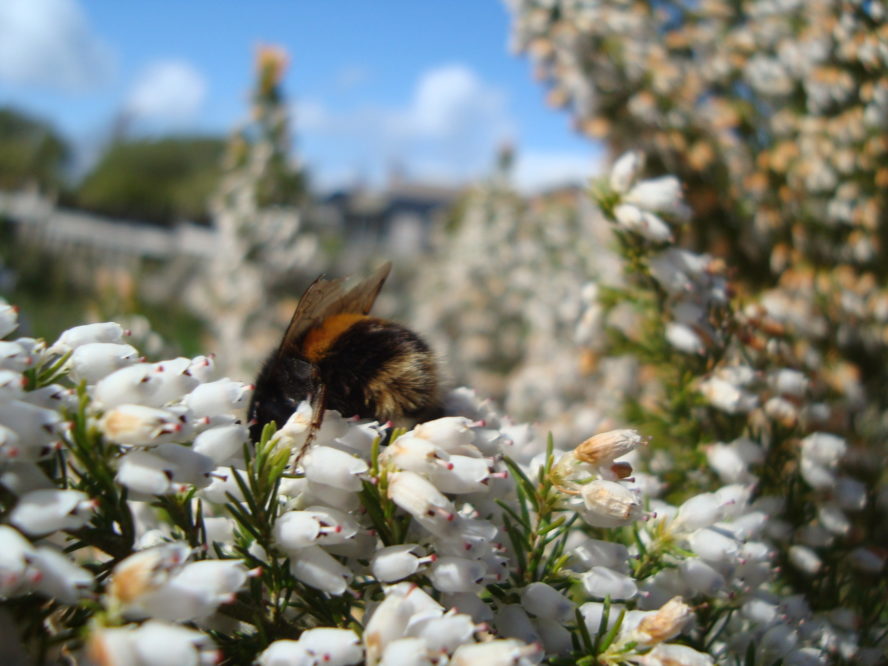Letter from Felinwynt, Ceredigion

Roni Roberts
It was over a decade ago now when the transformation of the field started. Trees and hedges were the original starting point. This was mainly through buying tree whips from my local garden centre, especially as I found that on the whole these small trees grew well and larger trees tended to take time to establish or even die back a little.
The scale and type of planting almost immediately evolved to include shrubs between the trees. Spare plants from friends and neighbours offered ground cover such as bugle which is early flowering and the bees love it.
Clearing beds
Then came the offer of clearing beds from more than one person’s garden and taking home the plants in the hope they’d cope with the move, and a surprising number did cope.
Ecosystem Restoration projects (such as re-greening in Saudi Arabia and the Loess Plateau in China showing how much we as humans can be a part of the solution rather than the problem inspired me.
Humans as Keystone species. Simply as much bio-diversity and bio-mass as possible ended up being my aim, although to begin with I’d thought I should only have native plants.

Some days were hard work, such as digging up a bed for a woman who wanted to turn her garden to grass. It is surprising how much fits into a Peugeot 206.
There was plenty more work for me after arriving home! Wooden pallets, moved to the field, created wonderful shelter from the prevailing wind for the little trees forming a hedge which grew so much quicker there than further down the field where I’d run out of pallets.
Exposed
Felinwynt is open and exposed from all sides. If I hadn’t seen how a neighbour had transformed her garden into a sheltered haven I would never have had the faith I could do this.
Within three years a rich and diverse habitat for an extraordinary number of birds and insects had emerged and this has continued to evolve.

A white flowering shrub came from that garden I cleared. A little carved rabbit is still lurking, now somewhere in the undergrowth.
Elders flowers bloom from what were once cuttings and I reaped the rewards of them within only a couple of years, producing elderflower champagne then also elderberry cordial and even wine.
They also evoke wonderful memories for me – as children we had no pop or squash but we did have elderflower champagne, which no-one else seemed to have heard of back then.
Pot bound
The beech tree must be nearly 15’ high and is densely leaved and vibrantly healthy. Having been slightly pot bound when it was planted here it has loved its new freedom and shot up.
A friend had rescued it and it had been nurtured in the pot hoping to find a good home. The trees in the distance are even taller and are from the original tiny whips planted beside the pallets.

This tree heather is another rescue, this time from a skip. It flowers very early and is the first plant of the season I see bees feeding on.
Flowering currant then offers another relatively early source of nectar, is pretty, grows extremely easily from cutting and makes good hedging. This is then followed by Weigela which attract the bees, especially bumble bees, in great profusion during their flowering season, enabling the bees to expend less energy since they don’t need to search wide and far one each foraging trip.
It is a deciduous shrub so leaf litter accumulates softening the ground and more insects can live there.
But for sheer quantity and range of insect life feeding off a flower there has been nothing as successful as mint one year which teemed with various bees, flies, hoverflies, many of which I’d never seen before.
Benefits
I had no idea of how many benefits transforming this field would have for me.
Yes, it was a lot of very hard work but the rewards were personal and communal as well as ecological.
During Covid, when the world had slowed down a little, I offered for people to pick elderflowers and fruit – raspberries, blackcurrants, rhubarb, gooseberries (not redcurrants as the blackbirds don’t share them!)
So many people feasted on nature’s abundance. Jam, wine, cordial. Women, men, children. Children helping (or not) their mothers, mothers expecting their mothers to make the jam, people exchanging interesting recipes, some of which of course contained memories for them.
I loved meeting so many people, I loved that this was a safe space and a valuable and productive one.
When the world speeded up again people didn’t find time so at present it is the more than human world which mainly feasts on nature’s bounty here.
Transformation
I feel immensely honoured to have witnessed this transformation. I feel so privileged to have been in a position to have played a small part in it.
Any work or effort on my part has been repayed a hunderfold.
The dawn chorus feeds my soul each morning, the colour, the vibrancy, the ever changing nature, the development of the trees and their individual characters emerging are all almost impossible to describe in words.
The interplay of space with time, the relationships between the flora and fauna, these take me out of the small human world and into a bigger and longer world view.
Roni Roberts works making artistic woodcraft. You can find out more about her and her work here.
Support our Nation today
For the price of a cup of coffee a month you can help us create an independent, not-for-profit, national news service for the people of Wales, by the people of Wales.




